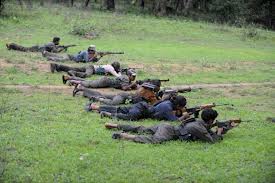 New Delhi: May 28: Intelligence inputs here suggest that Maoists’ politburo, the group’s highest decision-making body, had entrusted Left ideologue Katakam Sudarshan with the task of carrying out Saturday’s attack in Chhattisgarh to inflict the maximum damage on their target.
New Delhi: May 28: Intelligence inputs here suggest that Maoists’ politburo, the group’s highest decision-making body, had entrusted Left ideologue Katakam Sudarshan with the task of carrying out Saturday’s attack in Chhattisgarh to inflict the maximum damage on their target.The plan to ambush a convoy of Congress leaders was conceived by the seven-member politburo.
Sudarshan is also a politburo member. The 60-year-old from Andhra Pradesh operates under the assumed name of Anand. He enjoys the support of Maoists in Andhra Pradesh, who reportedly rejoiced after the killings.
A meeting is suspected to have taken place sometime in February or March in the Abujmarh area of Chhattisgarh where he was asked to plan the attack during the Maoists’ tactical counter-offensive campaign, which stretches every year from March-end to mid-June, said intelligence sources. During these months, local tribals, used as “Jan Militia,” are unemployed due to lack agricultural work.
The CPI (Maoist) had raised the “Jan Militia,” a special battalion, which is a term used to describe a part-time member of the Maoist group in charge of a village-level militia.
Left-wing groups
The group of 100-150 armed cadres who carried out the attack had Darbha divisional committee head Surender among its immediate instructors as Sudarshan does not participate in combats, said government officers handling left-wing groups.
The other members of the politburo are Ganpati Nambala Keshav Rao alias Gaganna, Mallojula Venugopal alias Vivek alias Bhupati, Mishir Besra alias Bhaskar, Kishan Da alias Prashant Boss alias Nirbhay and Malla Raji Reddy alias Sathenna.
Ministry of Home Affairs (MHA) officials, however, say the details of the perpetrators will emerge once the National Investigation Agency (NIA), which landed in Chhattisgarh on Monday, begins its probe.
Twenty-seven people, including Congress leaders Mahendra Karma, Pradesh Congress Committee chief Nand Kumar Patel, his son, and ex-MLA Uday Mudliyar were killed when their vehicles drove over mines, triggering blasts, in the Darbha area of Bastar district on Saturday. The wounded included former Union minister V C Shukla, who is undergoing treatment in Gurgaon.
The MHA and the Central Reserve Police Force (CRPF), the paramilitary force assisting the state in anti-Maoist operations, are still trying to ascertain why only Congress leaders were targeted.
Pradesh Congress Committee chief Nand Kumar Patel had never taken a hawkish stand against them.
Karma was a sworn enemy of the Maoists. He had raised “Salwa Judum,” a group of Maoist renegades the state was using to counter them.
After the MHA issued a notification, an NIA team led by Inspector General of Police Sanjiv Kumar Singh flew down to Raipur and went to Darbha to take over the investigation into the case from local police. The Darbha police had registered a case under various sections of the IPC, Arms Act, Explosive Act and Unlawful Activities (Prevention) Act over the attack.
A six-member delegation led by the home secretary and accompanied by the director-general of the Intelligence Bureau will go to Chhattisgarh on Tuesday to review the anti-Maoist strategy. The Centre has also decided to send another 2,000 paramilitary personnel drawn from the CRPF and the Border Security Force to augment the 32,000 already present in the state to tackle the Maoists.
Assembly elections are due in Chhattisgarh this year-end. Hence, Chhattisgarh, ruled by the Bharatiya Janata Party, has demanded more Central forces to combat the Maoist threat in the state.
The MHA on Monday issued an advisory to Andhra , Bihar, Chhattisgarh, Jharkhand, MP, Maharashtra, Odisha, UP and WB, asking them to check indiscriminate killings.





Comments
Add new comment